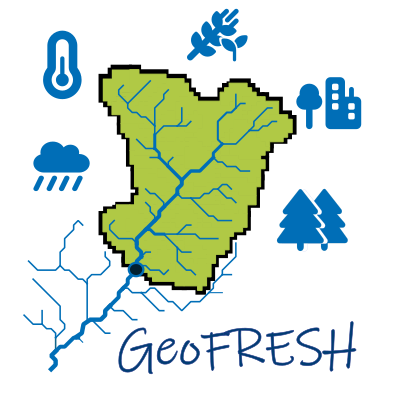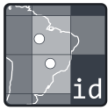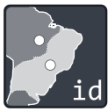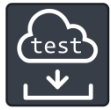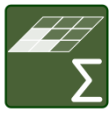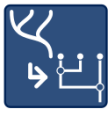GeoFRESH in a nutshell
Freshwater water bodies are highly connected with each other and with their
terrestrial catchments. In the light of climate and land use changes as well as
feedback mechanisms between earth systems, the integration of earth system data
into freshwater research is long-overdue to assess those interdependencies.
However, freshwater-specific characteristics like spatial connectivity and
fragmentation as well as legacy effects require a specialized workflow.
Within the first pilot project
“GeoFRESH: Getting freshwater spatio-temporal data on track”,
the aim was to built a prototype for a new online platform, called GeoFRESH.
The platform provides the integration, processing, management and visualization
of various standardized spatiotemporal freshwater-related earth system data.
The platform is built around
IGB GeoNode using RShiny
and includes the newly created
Hydrography90m dataset.
In the second pilot project
“Connecting rivers and lakes FAIRly”
we integrated lakes into GeoFRESH, currently based on the Hydrolakes dataset and
planned to be replaced by the NASA SWOT data. The aim for the third pilot project
“The seamless interoperability of geospatial freshwater tools”
is an improved interoperability and user experience of the GeoFRESH platform,
including interactive point snapping, an improved visualization, a connection to
the hydrographr R-package, and the integration of dams / barriers.
Development team: Vanessa Bremerich, Yusdiel Torres-Cambas, Afroditi Grigoropoulou,
Jaime R. García Márquez, Sami Domisch, Thomas Tomiczek, Merret Buurman
Proposal team: Sami Domisch, Giuseppe Amatulli, Luc De Meester, Hans-Peter Grossart,
Mark Gessner, Thomas Mehner, Vanessa Bremerich, Rita Adrian
Contact information: sami.domisch@igb-berlin.de
Source code:
github.com/glowabio/geofresh
License of the source code:
GPL-3.0 license
Bug reports and feature requests:
github.com/glowabio/geofresh/issues
Project duration:
Pilot 1: 01.04.2022 - 31.03.2023
Pilot 2: 01.10.2023 - 30.09.2024
Pilot 3: 01.03.2025 - 28.02.2026
Project funding:
NFDI4Earth (DFG)
This work has been funded by the German Research Foundation (DFG) through the
project NFDI4Earth (TA1 M1.1, DFG project no. 460036893,
www.nfdi4earth.de)
within the German National Research Data Infrastructure (NFDI,
www.nfdi.de).
Citation
Please cite the GeoFRESH platform as follows:
Domisch, S., Bremerich, V., Buurman, M., Kaminke, B., Tomiczek, T., Torres-Cambas,
Y., Grigoropoulou, A., Garcia Marquez, J. R., Amatulli, G., Grossart, H. P., Gessner,
M. O., Mehner, T., Adrian, R. & De Meester, L. (2024). GeoFRESH – an online
platform for freshwater geospatial data processing. International Journal of Digital Earth,
17(1).
doi.org/10.1080/17538947.2024.2391033
In addition, GeoFRESH relies on a number of external data sources regarding the
environmental data and we ask you to please use the following citations depending
on your analysis:
Topography (Hydrography90m)
Amatulli, G., Marquez, J.G., Sethi, T., Kiesel, J., Grigoropoulou, A., Ublacker,
M. M., Shen, L. Q., & Domisch, S. (2022). Hydrography90m: a new high-resolution
global hydrographic dataset. Earth System Science Data, 14(10), 4525-4550.
doi.org/10.5194/essd-14-4525-2022
Climate (CHELSA v2.1)
Karger, D.N., Conrad, O., Böhner, J., Kawohl, T., Kreft, H., Soria-Auza, R.W.,
Zimmermann, N.E., Linder, P., Kessler, M. (2017): Climatologies at high resolution
for the Earth land surface areas. Scientific Data, 4 170122.
doi.org/10.1038/sdata.2017.122
Karger, D.N., Conrad, O., Böhner, J., Kawohl, T., Kreft, H., Soria-Auza, R.W.,
Zimmermann, N.E., Linder, H.P. & Kessler, M. (2021) Climatologies at high resolution
for the earth’s land surface areas. EnviDat.
doi.org/10.16904/envidat.228.v2.1
Soil (SoilGrids250m)
Hengl, T., Mendes de Jesus, J., Heuvelink, G.B.M., Ruiperez Gonzalez, M.,
Kilibarda, M., Blagotić, A., Shangguan, W., Wright, M.N., Geng, X.,
Bauer-Marschallinger, B., Guevara, M.A., Vargas, R., MacMillan, R.A., Batjes,
N.H., Leenaars, J.G.B., Ribeiro, E., Wheeler, I., Mantel, S., & Kempen, B. (2017).
SoilGrids250m: Global gridded soil information based on machine learning.
PLOS ONE, 12(2), e0169748.
doi.org/10.1371/journal.pone.0169748
Landcover (ESA CCI LC)
ESA. Land Cover CCI Product User Guide Version 2. Tech. Rep. (2017). Available
at:
maps.elie.ucl.ac.be/CCI/viewer/download/ESACCI-LC-Ph2-PUGv2_2.0.pdf
Lakes (HydroLAKES v1.0)
Messager, M.L., Lehner, B., Grill, G., Nedeva, I., Schmitt, O. (2016).
Estimating the volume and age of water stored in global lakes using a
geo-statistical approach. Nature Communications, 7: 13603.
doi.org/10.1038/ncomms13603
Changelog
15.11.2024: Changed the unit of the climate CHELSA v2.1 variable “bio4” from
°C to °C/100 (following the CHELSA documentation)
19.08.2024: Publication online available at
doi.org/10.1080/17538947.2024.2391033
Updated tutorial
Minor user interface improvements
21.01.2025: Added lake intersection table containing information on a lake’s outlet, name and area for all points falling into a lake of the HydroLAKES dataset
NFDI4Earth
NFDI4Earth addresses
digital needs of Earth System Sciences. Earth System scientists cooperate in
international and interdisciplinary networks with the overarching aim to
understand the functioning and interactions within the Earth system and address
the multiple challenges of global change. NFDI4Earth is a community-driven
process providing researchers with FAIR, coherent, and open access to all relevant
Earth System data, to innovative research data management and data science methods.
GeoFRESH was initiated as part of the
first cohort of 1-year pilot projects:
in a first round in 2020, 14 pilots out of 38 were selected and started in April
2022. In the second round, seven (out of 27) pilots were funded and started in
2023. In the third round, another five pilots were funded, starting in 2025.
Further functionality of R package hydrographr
For further analyses of your freshwater data, you can use the hydrographr R package
that facilitates the download and data processing of the Hydrography90m data
(publication in
Methods in Ecology and Evolution,
website
with details and examples,
source code on GitHub).
For more details and an overview of the functions, please check the hydrographr panel.
